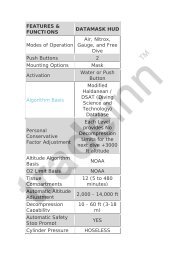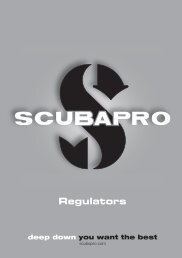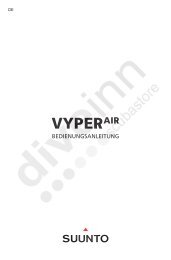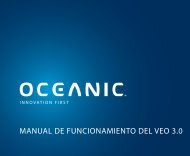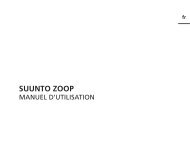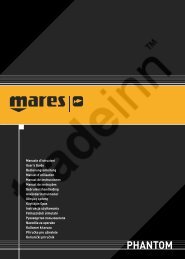Manual - Scubastore
Manual - Scubastore
Manual - Scubastore
You also want an ePaper? Increase the reach of your titles
YUMPU automatically turns print PDFs into web optimized ePapers that Google loves.
38 FIRST STAGES WARNING: intermediate pressure must be set only atauthorized Cressi-sub centres; the setting values must NOT andcan NOT be modified by the user, in order not to affect the goodworking of the regulator. Cressi-sub decline any responsibilityfor any intervention carried out by unauthorized personnel.Balanced diaphragm first stage features a light compact structurein chromium-plated brass with inner components in stainlesssteel, chromium-plated brass and state-of-the-art thermoplasticresins.It is supplied with four low pressure (LP) 3/8” ports - speciallyangled to allow the best hose positioning, avoiding any encumbranceamong different devices - and two high pressure (HP)7/16” ports with a micrometric air exit hole, guaranteeing maximumsafety even in the case of damage to the high pressurehose, since it greatly reduces air loss from the thank. WARNING: an underwater pressure gauge or a computerwith such function must be connected with the HP ports ofthe first stage.Since the tanks are not supplied with a reserve device, a pressuregauge must always be used, reporting the progressiveair consumption by diving and the reaching of reserve pressure,which has to be considered as not to be used by divingbut only as emergency air supply.Diving without any gauge is dangerous, since the diver cannot control his own air reserve, which might suddenly run out,at his own high risk.The first stage can be connected to the tank valve with an international,by means of an extremely modern designed bracket, orwith a threaded connection DIN 300 (EN 12209-1-2-3) bar, bothcomplyingwith EN 250:2000 standard.Like all Cressi-sub regulators, whose components are often interchangeableone with the other, MC9 is compatible with otherdiaphragm first stages of the present range.MC9 balanced diaphragm first stage, like other Cressi-sub diaphragmfirst stages as well, is to be recommended rather than otherpiston models, by diving in suspension or mineral salts rich water,or in cold water at temperature lower than 10 °C/50 °F. All innercomponents of the regulators are in fact perfectly watertight.For extreme conditions diving, we recommend our model MC9SC, supplied with a special Seal Chamber S.C.. WARNING: In case of dives in cold water (temperature lessthan 10°C/50° F), Cressi-sub recommend to use a tank suppliedwith a valve featuring two separate outlet ports, with which twocomplete regulators are to be connected. WARNING: diving in cold water at temperature lower than10°C/50 °F requires a special technical training. Cressi-subrecommend such diving only after attending a special trainingcourse by certified trainers. The regulator must absolutely notget wet and exposed to freezing air before use. Do not pressthe discharge button, particularly when the Venturi effectadjustment lever is on “dive”. If possible, keep the regulator ina warm place before use.The Seal Chamber’ s task is to make MC9 balanced diaphragmfirst stage perfectly watertight, preventing water from seepinginside or on the diaphragm and the main spring: it works as an airchamber above the regulator and its components, like a realthermal barrier. It avoids any problem caused by contact withsuspension, sand, mineral salts rich water and with cold water,which might eventually cause the regulator to freeze, especiallyat temperature lower than 10° C/50° F.fig. 2



